35 Squirrel Monkey Facts: All 5 Saimiri Species (Plus 8 Subspecies)
Is there anything cuter than a squirrel monkey? In this post, you’ll learn 35 squirrel monkey facts, including diet, range, all 5 species, and a couple of gross habits. We also cover specifics about baby squirrel monkeys, communication, and differences between the species. Plus lots of photos and videos.
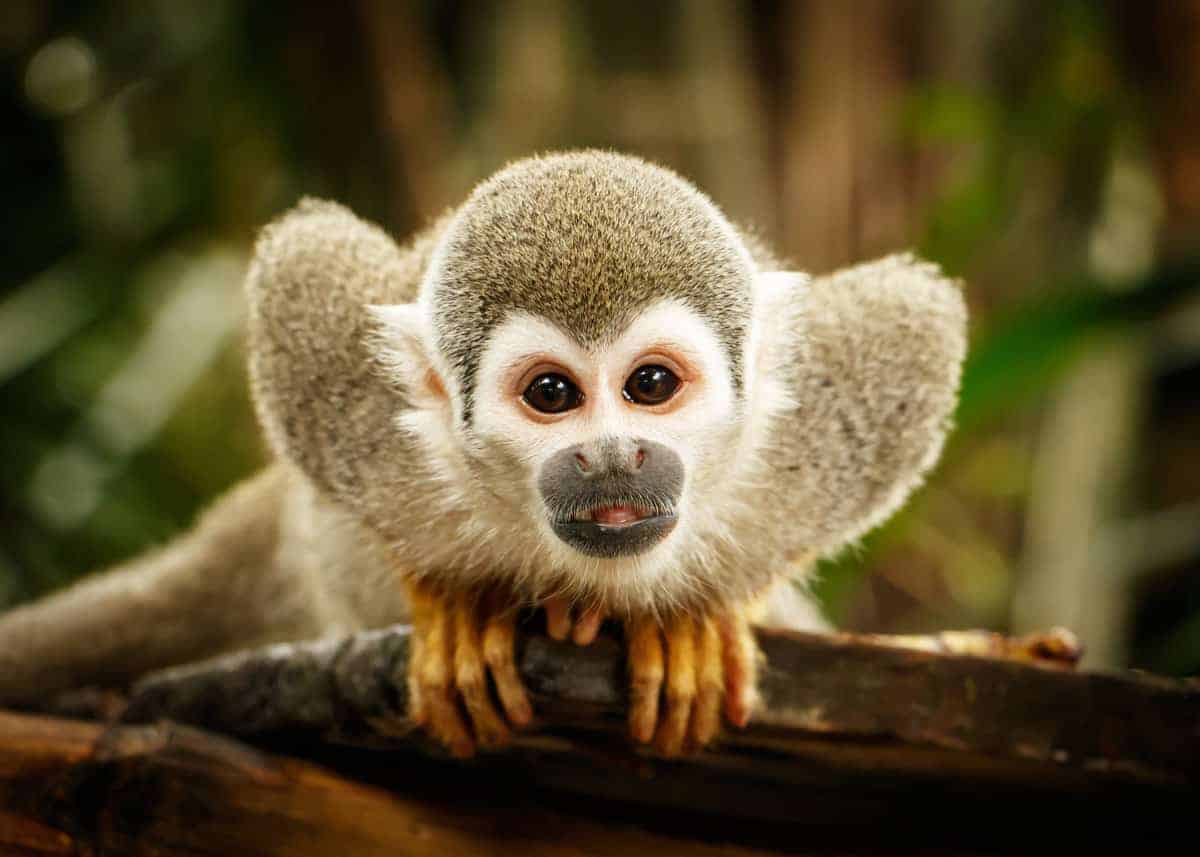
Travel tip: If you’re traveling to the Amazon, you should bring a camera with a good zoom and a decent pair of binoculars. This will increase the odds of spotting and shooting squirrel monkeys in the wild.
35 Facts About Squirrel Monkeys
Squirrel monkeys are some of the most unique creatures that you can find in the South American jungle. Not only do they have vivid colors, unusual mating habits and high-pitched calls that you can hear from a mile away, but they’ve also been woven into the fabric of human history. Squirrel monkeys went to space!
Do you want to know more about these fantastical animals? Here are just a few squirrel monkey facts to get you started.
1. Why are they called squirrel monkeys?
Squirrel monkeys get their name from their behavior.
They’re arboreal animals, meaning that they live in trees and spend most of their time hopping between branches. They’re also small, quick and nimble, so it’s probably inevitable that they were nicknamed after squirrels.
However, it should be noted that it’s only a nickname. Squirrel monkeys aren’t actually related to squirrels. In fact, their scientific name has nothing to do with squirrels at all; it translates to “small monkey” in a native South American tongue.
Squirrel monkeys were named for their tree-hugging habits in the same way that spider monkeys were named for their long, spider-like fingers.
2. What is the squirrel monkey scientific name?
Squirrel monkeys are the only species found under the saimiri classification of monkey, but they’re divided into two groups depending on their exact breed:
- Saimiri sciureus: The saimiri sciureus group includes the common squirrel monkey, the Central American squirrel monkey and the bare-eared squirrel monkey.
- Saimiri boliviensis: The saimiri boliviensis group includes the black squirrel monkey and the black-capped squirrel monkey.
There are also a couple of extinct squirrel monkey breeds that have only been identified thanks to fossils.
3. How many species of squirrel monkeys are there?
There are 5 species of squirrel monkeys in the saimiri genus.
4. What are the different species and subspecies of squirrel monkey?
There are 5 distinct species of squirrel monkey with an additional 8 subspecies.
- Common squirrel monkey (or Red backed squirrel monkey) Saimiri sciureus. There are 4 subspecies of the common squirrel monkey, including: Saimiri sciureus cassiquiarensis (Humboldt’s squirrel monkey), Saimiri sciureus macrodon (Ecuadorian squirrel monkey), Saimiri sciureus sciureus, and Saimiri sciureus albigena.
- Central American squirrel monkey Saimiri oerstedii. There are two subspecies of the Central American squirrel monkey: Saimiri oerstedii oerstedii (Black-crowned), and Saimiri oerstedii citrinellus (Grey-crowned).
- Bare-eared squirrel monkey Saimiri ustus
- Black squirrel monkey Saimiri vanzolinii
- Black-capped squirrel monkey Saimiri boliviensis. There are two subspecies of the Black-capped squirrel monkey: Saimiri boliviensis boliviensis (Bolivian squirrel monkey) , Saimiri boliviensis peruviensis (Peruvian squirrel monkey).
These breeds also have different scientific classifications of their own. For example, Central American squirrel monkeys can be classified as either black-crowned (saimiri oerstedii oerstedii) or grey-crowned (saimiri oerstedii citrinellus).
Most breeds are the same in terms of diet, behavior and habitat. They mostly vary in color and region.
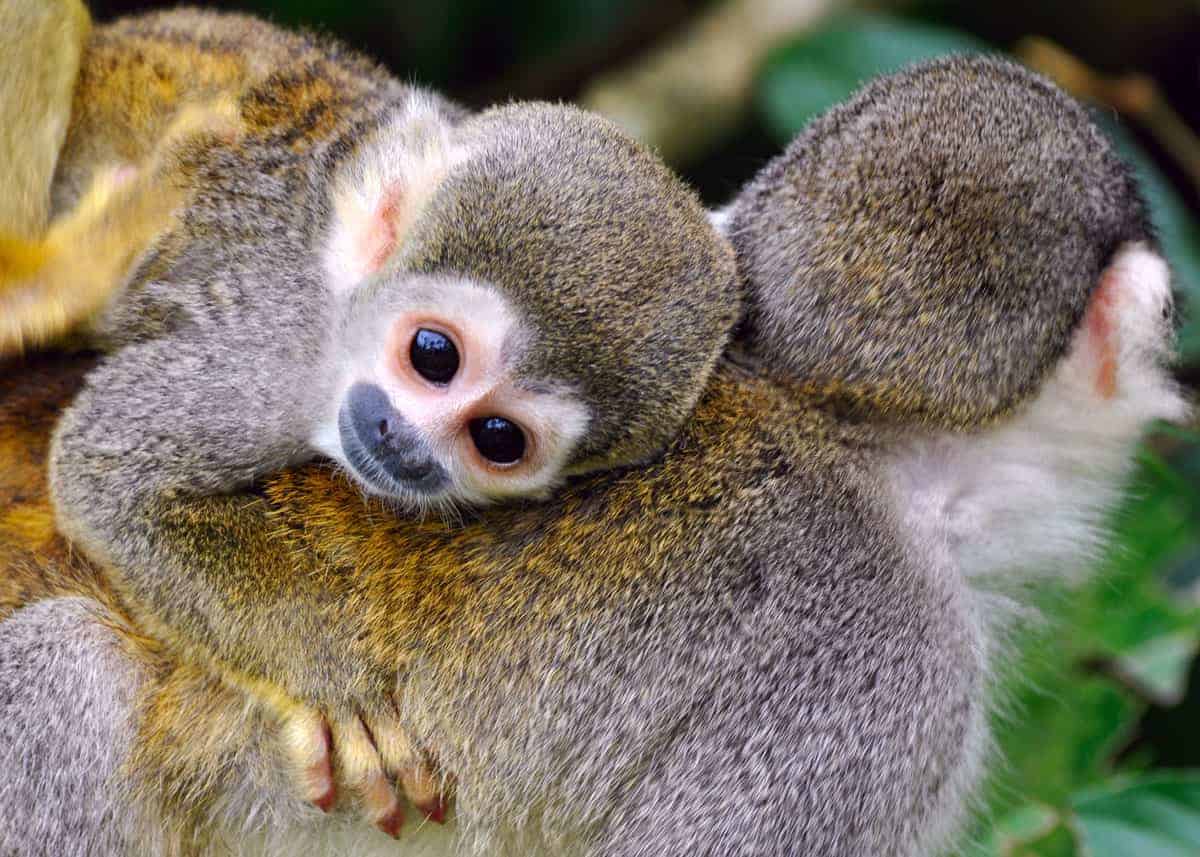
5. What happened to the extinct species of squirrel monkey?
There are two breeds of squirrel monkey, saimiri annectens and saimiri fieldsi, that have only been identified through fossils.
They weighed a bit more than modern squirrel monkeys and had bigger teeth. Their bones were found in the “monkey beds” of the Colombian Andes where there are hundreds of primate fossils.
No one is sure what happened to these extinct breeds, but it probably involved the same threats that are faced by today’s squirrel monkeys.
6. Are squirrel monkeys endangered?
The International Union for Conservation of Nature (IUCN) has assessed each breed of squirrel monkey.
Here are their findings:
- Common squirrel monkey: Least concern
- Black-capped squirrel monkey: Least concern
- Bare-eared squirrel monkey: Near threatened
- Black squirrel monkey: Vulnerable
- Central American squirrel monkey: Vulnerable
The Central American squirrel monkey is in the most trouble. There are less than 2,000 of them left in the wild, and their population is on a steep downward trend. They were actually classified as “endangered” until 2008, but the IUCN upgraded them after successful conservation efforts.
These conservation efforts have faltered, however, and most experts agree that it’s only a matter of time before they’re downgraded again.
7. Where are squirrel monkeys found?
Squirrel monkeys are a popular feature in zoos and animal sanctuaries worldwide, but they’re native to South and Central America. They can be found in places like Brazil, Bolivia, Colombia, Ecuador, Guyana, Peru, Panama and Venezuela.
Certain breeds are more prevalent in certain regions. For example, the black squirrel monkey has a very limited range in the Amazon rainforest while the common squirrel monkey is spread across thousands of miles and a half-dozen countries.
8. Why are squirrel monkeys considered “New World” monkeys?
When talking about plants and animals that span the globe, it’s common for biologists to separate them into “Old World” (Asia, Africa, Europe) and “New World” (North and South American) classifications.
Primates, in particular, can have some distinct differences depending on the hemisphere of their birth. For example, New World monkeys have flat noses and more teeth, but Old World monkeys are the ones with opposable thumbs.
As for squirrel monkeys, they’re considered New World monkeys since they’re native to South America.
9. What is the natural habitat of squirrel monkeys?
Squirrel monkeys spend 99% of their time in trees. They don’t venture too high or too low because they have natural predators on either side, so they stick to canopy environments where they can move safely and freely.
For this reason, squirrel monkeys almost always live in forests and jungles with plenty of cover. They’ll occasionally make do with marshes and mangroves that have a lot of trees, but they prefer denser, shadier areas.
They also like to be near water sources. There are several squirrel monkey breeds that live around the Amazon River, and many more congregate near streams, brooks and lakes.
However, squirrel monkeys rarely descend from the trees to drink from their water sources. They sip from puddles and tree holes rather than risking open exposure. They also get a lot of water from their food.
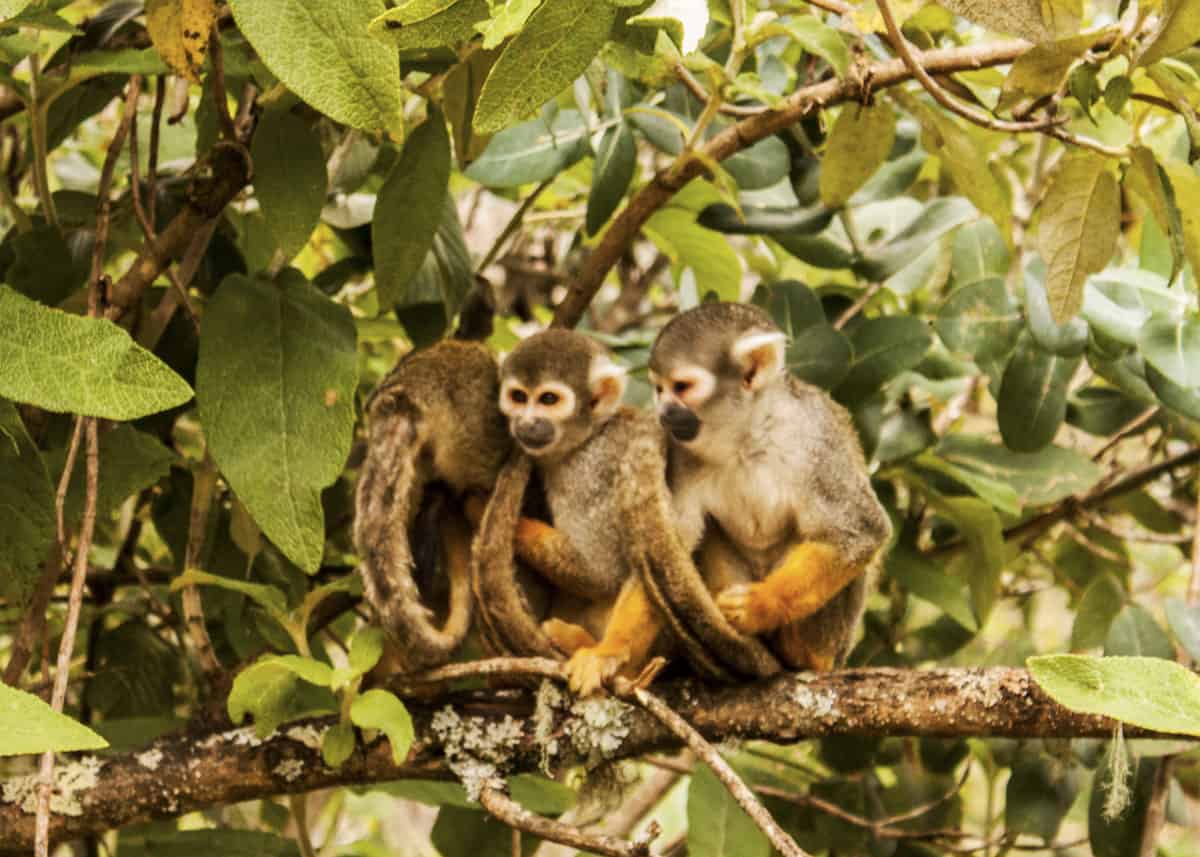
10. What do squirrel monkeys eat?
Squirrel monkeys are omnivores. While their primary diet is fruits, flowers, seeds and nuts, they also enjoy small bugs and reptiles such as grasshoppers, caterpillars, salamanders and tree frogs.
In captivity, they’ll munch on treats such as eggs and yogurts.
11. How are squirrel monkeys different from other monkeys?
Unlike many of their cousins, squirrel monkeys don’t have prehensile tails.
This means that they don’t use their tails for gripping or swinging through branches. It’s thought that the main purpose of their tails is to help them keep their balance as they run, jump, play, groom and sleep in the trees.
12. Do people experiment on squirrel monkeys?
Since their genetic makeup is quite similar to humans, squirrel monkeys are often tested, studied and utilized as stand-ins for human subjects during scientific research.
However, not all of these experiments are inhumane or unethical. The medical community has made significant progress in eyesight therapy by conducting non-invasive studies on color vision in squirrel monkeys.
There have also been famous squirrel monkeys like Miss Baker. She was one of the first animals to be successfully launched into space, and after completing a flight in her mini-helmet and mini-uniform, she served as an ambassador for the entire space program. She entertained visitors, guested on TV programs and received hundreds of letters from school children every day.
When she died, she was buried on the grounds of the U.S. Space and Rocket Center. To this day, her gravestone regularly receives bananas.
13. Do squirrel monkeys make good pets?
Squirrel monkeys are often sold as pets, but if you’re thinking about bringing one home, you should know that they’re demanding animals that will need a lot of special attention. Many rescue and rehabilitation centers are overrun with squirrel monkeys that were bought by people who didn’t know what they were getting into.
For example, you can’t make it too easy for squirrel monkeys to feed. They entertain themselves by foraging for food, and if you take that away, they’re prone to boredom and restlessness. Owners often have specific schedules and protocols for feeding their squirrel monkeys to keep them engaged and out of trouble.
You should also beware the range of motion of squirrel monkeys. They’re made to fling themselves from tree to tree, and they can reach heights of 6.5 feet with a single jump. They can easily clear fences, cages and other enclosures that are meant to keep them safe. They might even be able to leap atop your roof!
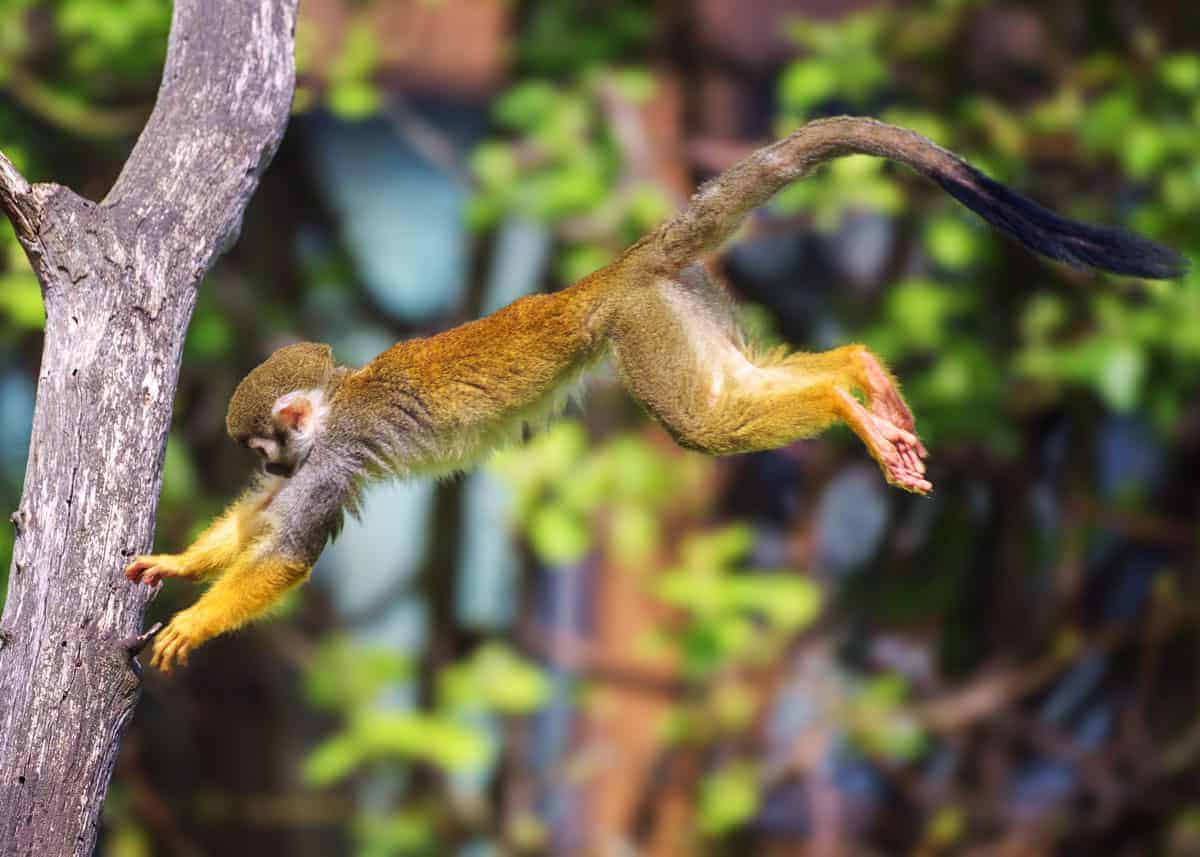
14. How big are squirrel monkeys?
Squirrel monkeys are quite small. Their bodies are just 9 – 14 inches long, and their weight usually hovers around 20 – 40 ounces.
Their most prominent feature is their tail. Measuring between 14 – 17 inches, it’s usually twice as long as their body and quick to curl around food, leaves, branches and other members of their species. While it can’t grip, it can still be used as a tool or a method of communication. It’s a very noticeable and versatile body part.
15. What will hunt and eat squirrel monkeys?
Squirrel monkeys have many predators. This is the main reason why they stick to such a rigid range in the trees. If they venture to the top of the canopy, they’re vulnerable to raptors, falcons, vultures and other birds of prey.
If they get too low, they’ll be snatched up by snakes, tigers, jaguars, weasels and leopards. Leopards are a particular concern since they can also climb trees; they can chase a squirrel monkey right into their natural habitat.
16. What is the lifespan of squirrel monkeys?
In the wild, squirrel monkeys live between 15 – 20 years.
They can double this number in captivity. According to the Animal Aging and Longevity Database, the oldest squirrel monkey on record was 30 years old when it died, and another hybrid squirrel monkey made it all the way to 32 years.
17. What do squirrel monkeys look like?
Squirrel monkeys have a very unique appearance. In addition to their small size, they’re also known for their “mask-like” face with white fur around their eyes and black fur around their mouths. It looks a lot like a skull, and some languages even translate their name to “death’s head monkey.”
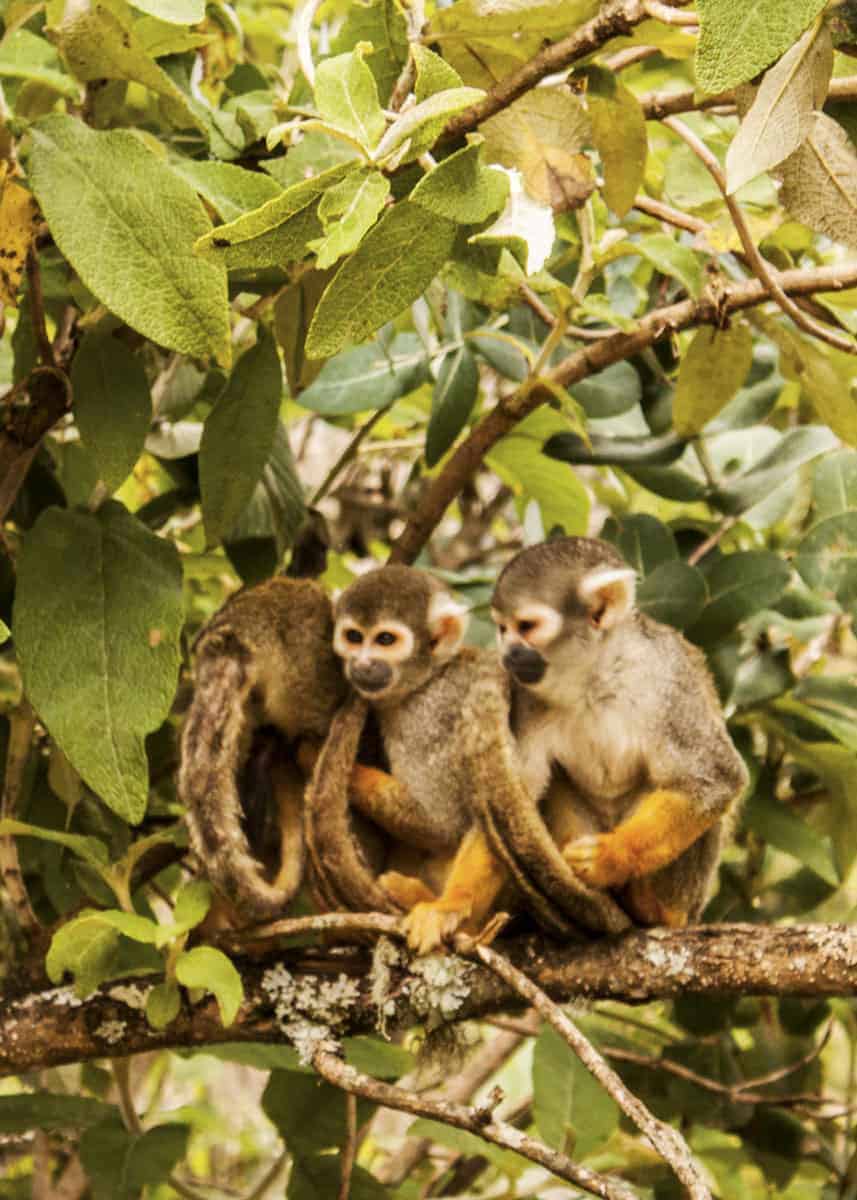
As for the rest of their fur, it can come in a variety of colors. A squirrel monkey might be black, brown, tan, orange, auburn or bronze. They might have black-tipped ears or tails.
One of the most eye-catching members of the species is the common squirrel monkey. They have white or grey fur with bright yellow arms and a black mask on their face, so they tend to stand out from the crowd. They’re popular attractions at zoos and fairs.
18. Do different breeds of squirrel monkeys look different?
Yes. While all squirrel monkeys have a mask, the mask’s appearance will vary between breeds.
For example, saimiri sciureus monkeys have a “gothic” arch with a dramatically-pointed V shape between their eyes, but the saimiri boliviensis monkeys have a “roman” arch that’s much softer and subtler.
There can also be differences in the color, texture and location of their fur. Bare-eared squirrel monkeys get their name from the fact that they have no hair protruding from their ears like the rest of their species.
Black-capped squirrel monkeys get their name from their “caps” of black, closely-matted head fur. Golden-backed squirrel monkeys have golden fur on their shoulders. The list goes on.
19. Are squirrel monkeys classified as mammals?
Yes. Squirrel monkeys are warm-blooded, air-breathing creatures that give birth to live babies, so they’re mammals. More specifically, they’re primates. Primates consist of both monkeys and apes.
20. How do squirrel monkeys find food?
Squirrel monkeys have excellent, full-color eyesight, and they can spot fruits and vegetables from many feet away. They’re also quite skilled at detecting motion, so if any tasty bug slithers down the branch where they’re resting, they can snatch it up and enjoy a snack.
Squirrel monkeys have also been known to spring traps for things like bats and lizards. They’ll find their nests and jump on them from above, and when the animal emerges in fear and panic, the squirrel monkey will strike. They have sharp claws and long fingers that make it easy for them to catch, hold and gut smaller prey.
21. Are squirrel monkeys intelligent?
Yes. Squirrel monkeys have one of the biggest brain-to-body ratios of the entire monkey family, and they’re quite adept at things like problem-solving.
They can use their hands and tails as tools for eating, playing and traveling, and they can communicate with several distinctive calls that are recognized and utilized depending on the situation.
In captivity, squirrel monkeys can also be trained to complete simple tasks or run through obstacle courses. This is why they’re frequently included in medical and scientific research. If you need a monkey to go into space, it’s best to choose a smart one.
22. How many squirrel monkeys live in a group?
Squirrel monkeys have large and active social groups called troops. While the average size of a troop is 50 – 100 monkeys, there have been reports of troops as big as 500 monkeys.
Within these troops, squirrel monkeys usually travel in different “groups” consisting of males, females, adolescents and mothers with children. While everyone will call out to each other in dangerous situations, they tend to play, feed, rest, groom and socialize within their particular group.
The females make up the majority of the troop. They work together to find food and raise their young. Males tend to keep their distance from the bigger groups unless it’s mating season.
23. Will squirrel monkeys stay with the same group?
It depends on the species. With common squirrel monkeys, females remain in their birth groups while males leave once they reach sexual maturity. They might live as solitary creatures, or they might join another mixed-gender troop. Some will even join a troop of unattached males like monkey bachelor bonding.
With Central American squirrel monkeys, however, the males are the ones that stay while the females leave. It isn’t known why they behave so differently from their cousins.
24. How do squirrel monkeys reproduce?
Females go into heat between August and October. Males get very aggressive during this time, and they’ll squabble and fight each other to gain access to different females.
Their bodies will also broaden around the shoulders to give them a strong, healthy appearance in hopes of attracting a mate. This “fattening” is due to an altered water balance and not any kind of dietary change, and it goes away once mating season is over.
Another unique characteristic of squirrel monkeys is that females don’t accept just any mate and they’ll also work together to drive off unwanted males during mating season. An interested male might approach them, but if the females aren’t in the mood, they’ll behave aggressively or chase him off with the help of their sisters, daughters and cousins.
25. When and where do squirrel monkeys give birth?
Female squirrel monkeys are pregnant for around five months. They give birth to a single baby, and they make sure to choose a safe, secluded spot to do it. This is usually a hole in a tree or tree trunk.
Females don’t get pregnant or give birth very often. Depending on the breed, it might take between 1 – 2 years for a female to have a single baby.
They usually handle the whole process alone. Males don’t play any part in child-rearing after birth.
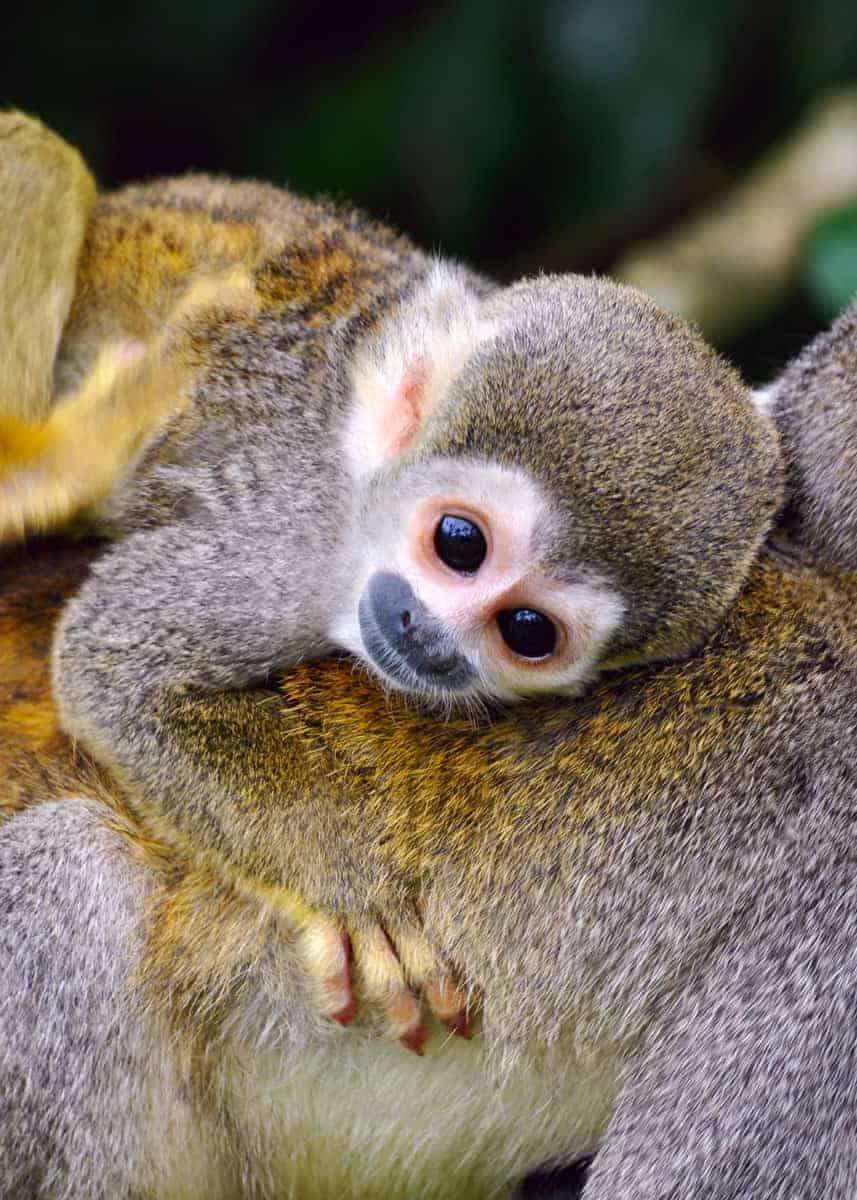
26. How long do baby squirrel monkeys stay with their mother?
Baby squirrel monkeys are entirely dependent on their mothers for the first few weeks of life. Eventually, they’ll start to explore the trees and socialize with other young monkeys through playing, feeding and grooming.
They reach full independence around 10 – 12 months old. This is when the males or females will start to break away from their birth troops and seek a new life elsewhere.
27. How many baby squirrel monkeys survive to adulthood?
It’s estimated that only around 50% of squirrel monkeys reach full maturity.
Their biggest danger period is when they’re newborns; they’re so small and helpless that they’re easy prey for birds, snakes, possums, weasels, toucans and big cats. There have even been cases of spider monkeys eating newborn squirrel monkeys.
28. How does a squirrel monkey protect itself?
The best defense for squirrel monkeys is to stick together.
In a large troop, they can have eyes and ears everywhere, and they can warn each other with high-pitched sounds when a predator enters their midst. Some troops have also been known to overwhelm small- and mid-sized predators and chase them off.
In terms of strength, squirrel monkeys aren’t completely defenseless, but their small size makes it difficult for them to do any real damage.
The sharpness of their claws and the dexterity of their fingers is mostly meant for foraging and grooming rather than fending off enemies. They might be able to escape something that isn’t much bigger than them, but generally speaking, they try to avoid trouble in the first place rather than fight it.
29. Do squirrel monkeys form alliances with other animals?
Yes. Squirrel monkeys have been observed working with capuchin monkeys to find food and watch out for predators.
In addition, they’ll tolerate the presence of certain squirrels and non-predatory birds that trail behind them and use them to find their own food.
More reading: Guide to Ecuador’s Rainforest Animals
30. Are squirrel monkeys nocturnal?
No. Like most monkeys, squirrel monkeys sleep at night after being active during the day.
While it isn’t unheard of for a squirrel monkey to go hunting or foraging after the sun sets, it isn’t common in the species as a whole.
31. What threats face the squirrel monkey?
Deforestation is the single biggest threat to the squirrel monkey.
They’re losing their habitat to everything from forest fires to construction projects, and as they’re pushed more and more out of their lands, they become increasingly vulnerable to outside dangers. Not only does this result in deaths, but it fragments their population and makes it harder for them to breed in large numbers.
Squirrel monkeys are also on the decline thanks to hunters and poachers. Monkey parts are used in a variety of medicines and fashion accessories, and squirrel monkeys in particular have very unusual colorings that make them prized possessions.
Some are bred for the express purpose of being pets or show animals, others are snatched out of the wild. It happens to both babies and adults, and it’s putting a stranglehold on breeds like the Central American squirrel monkey.
32. Is the squirrel monkey an invasive species?
While not technically classified as an invasive species, squirrel monkeys can be quite the nuisance for South American farmers.
They tend to raid crops and fields when they aren’t finding enough food in the wild, and since they eat all kinds of bugs, plants, seeds and small reptiles, they can impact a local ecosystem. It isn’t uncommon for farmers to shoot a squirrel monkey on sight.
33. How do squirrel monkeys communicate?
Squirrel monkeys are very active communicators. They cry, shriek, peep, call and cackle depending on the situation. Danger sounds are usually loud and high-pitched while aggressive posturing during a fight is lower and almost growl-like.
Squirrel monkeys also have a pretty unique method of non-verbal communication: urine. They’ll rub their hands and feet with their own pee so that they’ll leave scent trails as they jump around the jungle. The other members of their troop can smell it and follow it.
34. How often do squirrel monkeys sound off an alarm cry?
Squirrel monkeys have hair-trigger instincts when it comes to danger.
This is especially pronounced when they’re high up in the trees; they’re so alert towards birds of prey that they’ll shriek a warning and dive for cover if a particularly large branch falls over. They’ve also been recorded making alarm cries for airplanes and other airborne objects.
You can hear their warning shriek near the end of the following video.
35. Do squirrel monkeys have opposable thumbs?
No. This is one of the differences between “New World” and “Old World” monkeys: New World monkeys don’t have opposable thumbs while Old World monkeys do.
It should be noted, however, that even if squirrel monkeys don’t have opposable thumbs, their thumbs still exist and are still quite nimble. For this reason, they’re sometimes said to have “semi-opposable” thumbs to distinguish their digits from other animals that completely lack strength or flexibility in their hands.
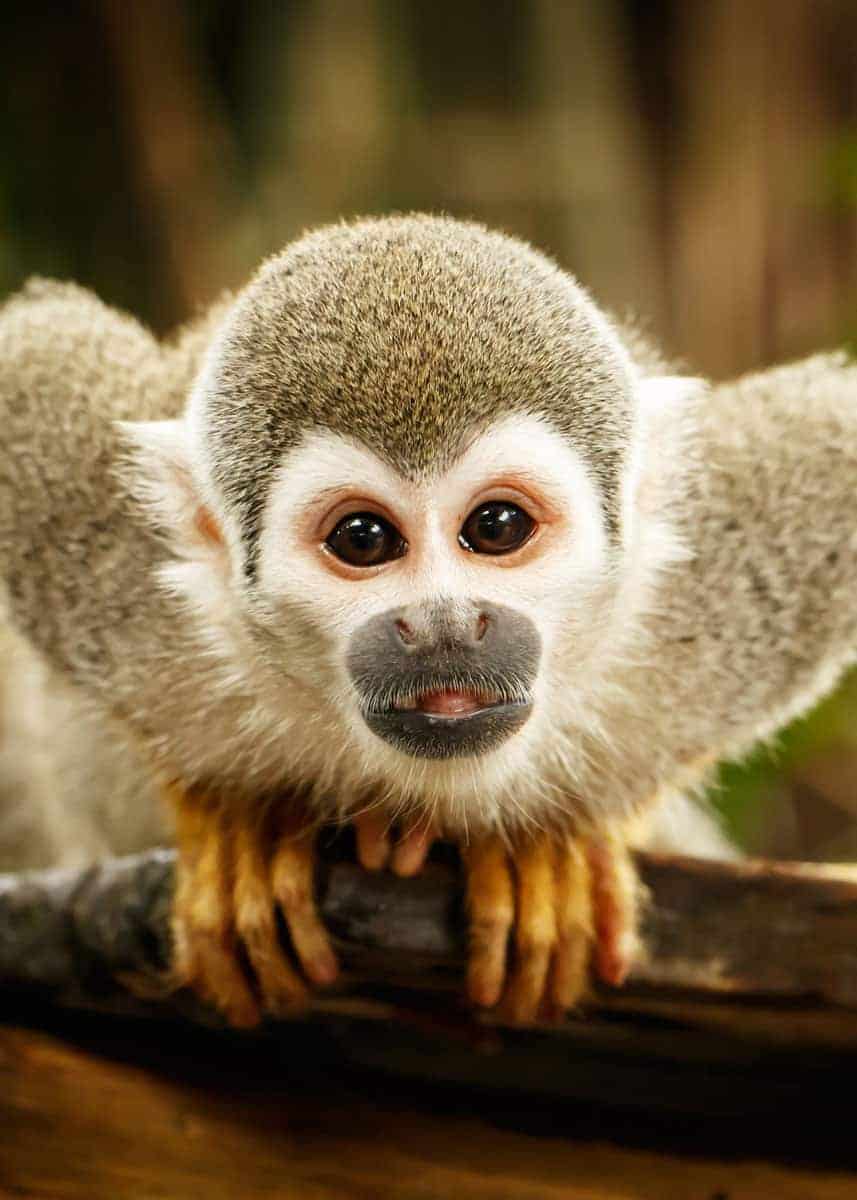
Learn more about another monkey from the Amazon, the tiny pygmy marmoset.
Your turn
Squirrel monkeys are fun to watch, with their vivid colors and crazy sounds. And when you look a little deeper, they’re also smart, social creatures with complex group dynamics.
Have a fact to add? Or a question about squirrel monkeys? Have you seen these in the wild? Let me know below!






